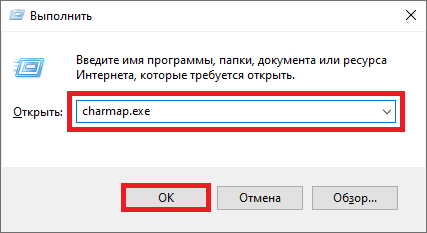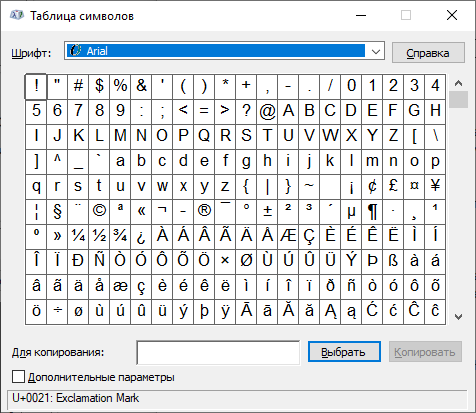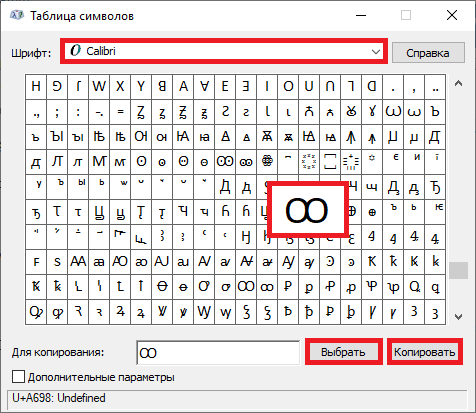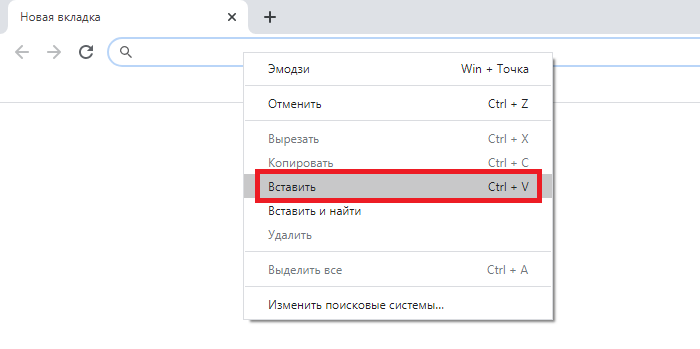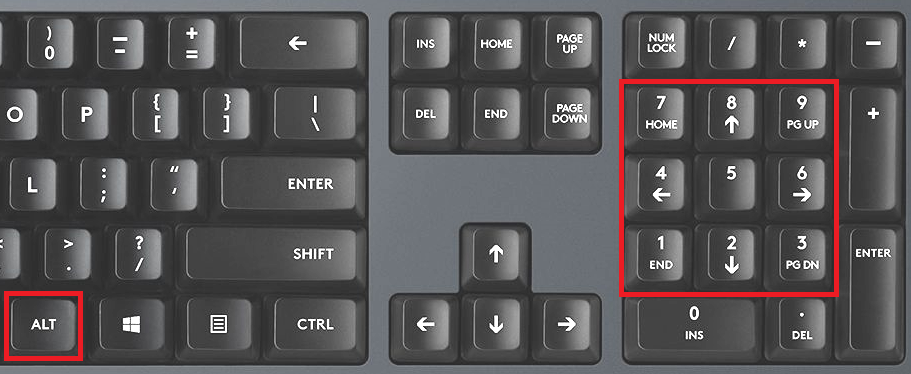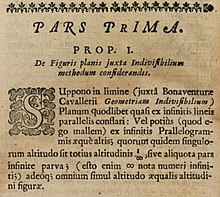Содержание материала
- Кодировка символа бесконечности
- Видео
- Специальные кодовые знаки, о которых мало кто знает
- Обозначение знака бесконечности
- Скопировать
- Эзотерика
- История знака бесконечности
- Учение “апейрон” философа Анаксимандра
- Изображение змеи/дракона Уроборос
- Скопировать знак бесконечности в ВК
Кодировка символа бесконечности
| Платформа | Сочетание клавиш | Описание |
|---|---|---|
| Компьютер с Windows | Alt + 236 | удерживая клавишу ALT, набрать 236 на цифровой клавиатуре; |
| Apple macOS | Option + 5 | удерживая клавишу Option, нажать 5; |
| Microsoft word и Microsoft excel |
|
|
| Вебсайт | Ctrl+C → Ctrl+V | Скопировать знак здесь ∞ и вставить его на свою веб-страницу |
| Код для ВК |
|
|
| Символ бесконечности HTML |
∞ |
|
| Юникод | U+221E | |
| CSS-код | 221E | |
| ASCII | 236 | |
| LaTeX и MATLAB | infty |
Видео
Специальные кодовые знаки, о которых мало кто знает

На данном этапе предстоит познакомиться с использованием сочетания клавиши Alt с другими для ввода необычных значков. Как понятно из описания, правильное выполнением команды будет заключаться в следующем:
- Найдите на клавиатуре кнопку с надписью Alt.
- Нажмите и удерживайте её.
- После этого нажмите на другую интересующую вас клавишу с обозначением цифры на NumPad.
- Можно вводить целое число, например, Alt + 123. При этом удерживая Alt и не отпуская до полного ввода желаемой комбинации.
- После этого на экране должно появиться отображение желаемой фигуры.
Существует много различных изображений, получаемых данным способом, их число насчитывается до нескольких сотен и больше. Мы рассмотрим десять возможных вариантов. При желании изучить полный список элементов, можете испробовать этот алгоритм для каждой кнопки и записать наиболее понравившиеся из них.
- Начинается последовательность с сочетания с 1. Получится милый смайлик.
- При комбинации с двойкой появится чёрно-белый смайлик.
- После этого идёт колода карт. На тройке расположены червы.
- Четверка — бубны.
- Пятерка обозначает трефы.
- Для пик используйте сочетание с шестеркой.
- Затем идёт Alt+7 для обозначения точки посередине строчной прописи.
- Для 8 квадратик с закругленными углами.
- 9 нарисует кружок.
- 10 выведет на экран черный квадрат с белым кругом внутри.
- Дальше идут: символы мужского и женского пола, мелодии, солнца, стрелок, двойного восклицания…
Все это вы можете напечатать при помощи классических символов на самой обычной клавиатуре. Можете также попробовать изменить раскладку, от этого тоже много зависит. Печатайте нестандартные изображения и удивляйте собеседников, ведь такие знаки используются очень редко и практически не встречаются в классических текстах.
Обозначение знака бесконечности
Простой способ осуществить ввод знака бесконечности на клавиатуре — это с помощью клавиши Alt. Для этого убедитесь, что включен NumLock и боковые цифровые клавиши активны. Зажмите кнопку alt и, удерживая ее наберите комбинацию 8734, отпускайте Альт и наслаждайтесь.
Важно! В зависимости от того, где вы набираете эту комбинацию, могут получаться разные символы, все зависит от применяемого шрифта. В Microsoft Word точно получится знак бесконечность, а на клавиатуре техники фирмы Apple это не сработает.
Если такую же комбинацию ввести в строке браузера, вы, скорее всего, получите ▲. Все зависит от шрифта, применяемого для каждого сайта, приложения, программы.
В операционной системе Mac OS X от Apple знак бесконечности вставляется сочетанием клавиш Option+5
Скопировать
Если не получается ввести символ при помощи клавиш, то есть более простой способ, имеющий право на жизнь. Скопируйте на стороннем ресурсе символ бесконечности, сохраните его в блокнот или в файле Ворд. Используйте при необходимости.
Эзотерика
Согласно философским взглядам, положенная набок циферка означала цикл человеческой жизни. Свое существование человек начинает и заканчивает в одной петле, а после смерти переходит во вторую. Цикл повторяется, только в другом измерении и продолжается бесконечно.
Число неспроста считается магическим, объединяя в себе две противоположности, как Инь и Ян, жизнь и смерть, день и ночь. Непрестанность цикла, замена одного другим, неразрывность, следование друг за другом – удивительные значения, которые впитала в себя циферка.
История знака бесконечности
Символ бесконечности (∞) был создан Джоном Уоллисом, английским математиком в 1655 году. Однако само понятие бесконечности было задокументировано ещё с древнегреческих времён.
Учение “апейрон” философа Анаксимандра
Самые ранние записи идеи бесконечности датируются ещё 610 – 546 гг.
Древнегреческий философ Анаксимандр полагал, что Вселенная возникла из апейрона (вечное движение времени), на греческом это означает “бесконечный” или “неограниченный”.
Философия Анаксимандра заключалась в том, что апейрон приводит к тому, что по мере возникновения мира противоположности (такие как жар и холод, ночь и день) отделяются друг от друга.
Изображение змеи/дракона Уроборос
Посредством изображения Уроборос (змеи, которая поедала свой собственный хвост) мир искусства передал идею, похожую на бесконечность. Этот образ считается самым старым и известным изображением бесконечности. Уроборос был у греков в 400 году нашей эры, но символ фактически восходит ещё к Древнему Египту, к 14 веку до нашей эры.
Иногда Уроборос изображается как две переплетённые змеи, или как змея в форме восьмёрки, или в форме круга. Зачастую это изображение интерпретируется как цикл жизни и смерти, но существуют и другие толкования.
Скопировать знак бесконечности в ВК
Самый просто способ – скопировать знак бесконечности и вставить в ВК. Для неопытных пользователей, наверное, стоит упомянуть, что для того, чтобы скопировать необходимо одновременно нажать клавиши Ctrl+C, а вставка производится c помощью горячих клавиш Ctrl+V.
∞ — знак бесконечности.
Недостаток этого способа в том, что вам придется каждый раз заходить на мой сайт, чтобы скопировать символ, чему, признаться, я рад, ведь хорошим людям всегда тут рады ?
Для поиска этого и других символов можно использовать специализированные онлайн-сервисы, например, сайт:
Таблица символов Юникода
Также можно использовать таблицу символов Windows. Для этого необходимо открыть меню «Пуск», зайти в «Программы» — «Служебные» — «Таблица символов». Либо – просто вписать в поиске Windows – «Таблица символов».
Теги
Как поставить на ПК и ноутбуках с операционной системой Windows?
В Windows существует таблица символов. В ней можно искать и копировать различные буквы, цифры и знаки.
- Откройте меню «Пуск».
- В строке «Найти программы и файлы» введите «Таблица символов».
- Пролистайте и найдите бесконечность среди предложенных знаков.
- Нажмите на соответствующую ячейку, воспользуйтесь кнопкой «Выбрать» и скопируйте значок в буфер обмена.
- Вставьте его в текст комбинацией «Ctrl + V».
Существуют ещё несколько универсальных вариантов. Первый из них – пользователь просто копирует символ бесконечности из этой статьи (∞) и вставляет его при нужном числе. Второй – когда зажата клавиша Alt, надо набрать на нумпаде (цифровой клавиатуре справа) число 8734. Когда отпустите кнопки, она появится автоматически.
Как ввести на макбуке или аймаке (операционная система MacOS)?
- Нажмите комбинацию «Command + Control + Пробел».
- Введите внутри поля поиска название символа бесконечности.
- Выберите подходящий шрифт для написания.
- Дважды щёлкните по нему.
Существует другой вариант для Mac. Вы одновременно нажимаете клавишу «Option» и цифру «5» на клавиатуре.
Как написать знак бесконечности на телефоне?
На мобильном телефоне нет возможности поставить бесконечность при помощи сочетаний клавиш. Но здесь есть свои варианты для ввода данного символа.
Айфон
В iOS бесконечность есть на клавиатуре эмодзи. Необходимо перейти в предпоследнюю вкладку и найти среди математических символов нужный нам знак бесконечности.
Андроид (Самсунг и т.д.)
Здесь точный способ будет зависеть от возможностей, которые заложил производитель. Например, на многих смартфонах можно найти кнопку со значком равенства на клавиатуре. Удерживая её, вы увидите над клавишей несколько вариантов, одним из которых будет бесконечность.
Универсальный способ – можно скопировать данный математический значок из нашей статьи (∞).
Как ввести на популярных сайтах или мессенджерах?
Многие мессенджеры предлагают свои эмодзи, среди которых можно попробовать поискать такой значок. Но если его нет, не отчаивайтесь: можно воспользоваться любыми другими способами, которые предусмотрены в вашей операционной системе.
Как напечатать в эксель (табличный редактор Microsoft Office Excel)?
Если вам необходимо добавить бесконечность в таблицу Excel, можно пойти следующим путём:
- Перейдите во вкладку «Вставка».
- В разделе «Символы» выберите функцию «Символ».
- Открылось новое окно, в меню «Набор» найдите «Математические операторы».
- Кликните по знаку в таблице.
- Нажмите «Вставить»
Готово! Нужный знак появился в ячейке таблицы Excel.
Как напечатать в ворде (текстовый редактор Microsoft Office Word)?
Вставка в документ Word полностью аналогична последовательности действий в Excel: «Вставка» – «Символы» – «Символ» – «Математические операторы».
Но в Word существует ещё один способ. Набираем шестнадцатеричный код 221E, а затем одновременно нажимаем по кнопкам «Alt» и «X».
Таблица символов
Бесконечности в разных кодировках соответствуют следующие коды:
| Система | Символы |
|---|---|
| HTML-мнемоники | ∞ или ∞ или ∞ |
| Юникод | U+221E |
| ASCII-код | 8734 |
Теперь вы знаете несколько способов, как напечатать знак бесконечности на клавиатуре для текстовых редакторов, мессенджеров и других программ. Пользуйтесь тем, который доступен для вашего компьютера, ноутбука или смартфона и будет вам наиболее удобен.
Знак бесконечности — это математический символ, представляющий концепцию бесконечности. Фактически это символ, который практически полностью копирует цифру 8, которая оказывается перевернутой под углом 90 градусов. На клавиатуре этого символа нет — можете не искать. Тем не менее, набрать его можно. Как?
Первый способ
Используем таблицу символов.
Нажимаете Win+R.
Добавляете в появившееся окно «Выполнить» команду charmap.exe, после чего нажимаете ОК.
Перед вами — таблица символов.
Выбираете шрифт Calibri (можно использовать и другой), затем находите символ бесконечности, кликаете по нему, после чего кликаете по кнопкам «Выбрать» и «Копировать» — именно в такой очередности.
Вставляете в нужное место в строке.
Готово.
Второй способ
Актуален только для некоторых текстовых редакторов, в их числе — Word.
Находите цифровую клавиатуру в правой части клавиатуры своего компьютера или ноутбука, включаете ее нажатием на клавишу Num Lock при необходимости.
Далее зажимаете кнопку Alt и вводите цифры 8734, после чего убираете палец с кнопки Alt. Если не получается с правым Alt, используйте левый.
Должно сработать, но только в текстовом редакторе.
Третий способ
Просто скопируйте символ из этой строки и вставьте его в нужное вам место — Ꚙ или ꚙ или ∞.
Знак бесконечности — математической символ, графически представляет концепцию бесконечности. Чтобы набрать его на клавиатуре, нужно использовать комбинацию Alt+8734. Число вводится с цифровой панели при включенном Num Lock.
В 1655 году математик Джон Валлис первым обозначил бесконечность именно таким ∞ значком в своём трактате «о конических сечениях». Тогда он не объяснил, почему избрал именно этот символ. А сейчас уже и не спросишь. По одной версии, это связано с римским числом 1000 (изначально выглядевшим так ↀ, или так CƆ). По другой — с последней буквой греческого алфавита омегой (ω). Применяется этот знак, в основном, в математике. Помню, как чувствовал себя обманутым, когда узнал, что на ноль делить, всё-таки, можно. А простым смертным, такие категории человеческого мышления ни к чему. Какая разница есть ли края у вселенной, если нам даже до соседней галактики — как до луны пешком.
Сам символ упавшей восьмёрки значительно старше. Возможно, он связан с уроборосом — змеёй, проглотившей свой хвост. Такие символы присутствовали в наскальных надписях, обнаруженных в Тибете.
Символ «Бесконечность» был утвержден как часть Юникода версии 1.1 в 1993 г.
Как набрать на клавиатуре знак бесконечности?
-
Категория ~
Технические советы -
– Автор:
Игорь (Администратор)

Метод 1. Скопируйте знак бесконечности
Вот знак бесконечности: ∞
Метод 2. Комбинация клавиш с Alt
Данный метод действует далеко не везде, учитывайте это. Например, в WordPad отображается символ бесконечности, а в обычном блокноте или же в строке браузера нет (там будет ▲). Сам метод. Зажмите кнопку «Alt», наберите «8734» (в правой колодке клавиатуры) и отпустите «Alt». Должен появиться знак ∞.
Метод 3. В Word с помощью комбинации Alt + X
В Ворде наберите «221E» (без кавычек), а затем нажмите комбинацию клавиш «Alt + X». Вместо кода появится знак бесконечности.
Метод 4. В Html
При редактировании html, можно использовать специальные конструкции «∞» или «∞» (в обоих вариантах без кавычек). При отображении, вместо конструкций появится символ бесконечности.
Метод 5. С помощью таблицы символов
Откройте меню Пуск и в поиске наберите «таблица символов». Выберите пункт с одноименным названием. Откроется окно с символами. В нем можно либо вручную найти знак бесконечности, либо можно сделать следующее. Внизу в выпадающем списке «Группировка» выберите пункт «Диапазоны Юникода». Откроется небольшое окно, в нем необходимо выбрать пункт «Математические операторы». Во второй строке по середине будет символ бесконечности, Щелкните по нему. Затем нажмите кнопку «Выбрать» под таблицей и скопируйте символ из текстового поля рядом (или нажмите кнопку «копировать»). Дальше вставьте бесконечность там, где вам необходимо.
Так же возможно вас заинтересует:
1. Как набрать апостроф на клавиатуре.
2. Как набрать на клавиатуре римские цифры.
3. Как набрать сердечко на клавиатуре.
4. Как написать степень на клавиатуре.
5. Как написать корень на клавиатуре.
Подписывайтесь в социальных сетях и делайте репосты!
☕ Понравился обзор? Поделитесь с друзьями!
-
Как на клавиатуре набрать градус цельсия?
Технические советы -
Как на клавиатуре набрать собаку?
Технические советы -
Как набрать знак рубля на клавиатуре?
Технические советы -
Зачем нужно устанавливать антивирус и файрвол?
Технические советы -
Как понять нужен ли второй монитор?
Технические советы -
Как отключить Дзен в Яндекс.Браузере?
Технические советы
Добавить комментарий / отзыв
From Wikipedia, the free encyclopedia
 |
|
|---|---|
|
Infinity symbol |
|
| In Unicode | U+221E ∞ INFINITY (∞) |
| Different from | |
| Different from | U+267E ♾ PERMANENT PAPER SIGN U+26AD ⚭ MARRIAGE SYMBOL |
The infinity symbol (
This symbol was first used mathematically by John Wallis in the 17th century, although it has a longer history of other uses. In mathematics, it often refers to infinite processes (potential infinity) rather than infinite values (actual infinity). It has other related technical meanings, such as the use of long-lasting paper in bookbinding, and has been used for its symbolic value of the infinite in modern mysticism and literature. It is a common element of graphic design, for instance in corporate logos as well as in older designs such as the Métis flag.
Both the infinity symbol itself and several variations of the symbol are available in various character encodings.
History[edit]
First known usage of the infinity symbol, by John Wallis in 1655
John Wallis introduced the infinity symbol 
The lemniscate has been a common decorative motif since ancient times; for instance it is commonly seen on Viking Age combs.[4]
The English mathematician John Wallis is credited with introducing the infinity symbol with its mathematical meaning in 1655, in his De sectionibus conicis.[5][6][7] Wallis did not explain his choice of this symbol. It has been conjectured to be a variant form of a Roman numeral, but which Roman numeral is unclear. One theory proposes that the infinity symbol was based on the numeral for 100 million, which resembled the same symbol enclosed within a rectangular frame.[8] Another proposes instead that it was based on the notation CIↃ used to represent 1,000.[9] Instead of a Roman numeral, it may alternatively be derived from a variant of ω, the lower-case form of omega, the last letter in the Greek alphabet.[9]
Perhaps in some cases because of typographic limitations, other symbols resembling the infinity sign have been used for the same meaning.[7] Leonhard Euler used an open letterform more closely resembling a reflected and sideways S than a lemniscate,[10] and even «O–O» has been used as a stand-in for the infinity symbol itself.[7]
Usage[edit]
Mathematics[edit]
In mathematics, the infinity symbol is used more often to represent a potential infinity,[11] rather than an actually infinite quantity as included in the extended real numbers, the cardinal numbers and the ordinal numbers (which use other notations, such as 
the infinity sign is conventionally interpreted as meaning that the variable grows arbitrarily large towards infinity, rather than actually taking an infinite value, although other interpretations are possible.[12]
The infinity symbol may also be used to represent a point at infinity, especially when there is only one such point under consideration. This usage includes, in particular, the infinite point of a projective line,[13] and the point added to a topological space to form its one-point compactification.[14]
Other technical uses[edit]
Side view of a camera lens, showing infinity symbol on the focal length indicator
In areas other than mathematics, the infinity symbol may take on other related meanings. For instance, it has been used in bookbinding to indicate that a book is printed on acid-free paper and will therefore be long-lasting.[15] On cameras and their lenses, the infinity symbol indicates that the lens’s focal length is set to an infinite distance, and is «probably one of the oldest symbols to be used on cameras».[16]
Symbolism and literary uses[edit]
In modern mysticism, the infinity symbol has become identified with a variation of the ouroboros, an ancient image of a snake eating its own tail that has also come to symbolize the infinite, and the ouroboros is sometimes drawn in figure-eight form to reflect this identification—rather than in its more traditional circular form.[18]
In the works of Vladimir Nabokov, including The Gift and Pale Fire, the figure-eight shape is used symbolically to refer to the Möbius strip and the infinite, as is the case in these books’ descriptions of the shapes of bicycle tire tracks and of the outlines of half-remembered people. Nabokov’s poem after which he entitled Pale Fire explicitly refers to «the miracle of the lemniscate».[19] Other authors whose works use this shape with its symbolic meaning of the infinite include James Joyce, in Ulysses,[20] and David Foster Wallace, in Infinite Jest.[21]
Graphic design[edit]
The well-known shape and meaning of the infinity symbol have made it a common typographic element of graphic design. For instance, the Métis flag, used by the Canadian Métis people since the early 19th century, is based around this symbol.[22] Different theories have been put forward for the meaning of the symbol on this flag, including the hope for an infinite future for Métis culture and its mix of European and First Nations traditions,[23][24] but also evoking the geometric shapes of Métic dances,[25], Celtic knots,[26] or Plains First Nations Sign Language.[27]
A rainbow-coloured infinity symbol is also used by the neurodiversity movement, as a way to symbolize the infinite variation of the people in the movement and of human cognition.[28] The Bakelite company took up this symbol in its corporate logo to refer to the wide range of varied applications of the synthetic material they produced.[29] Versions of this symbol have been used in other trademarks, corporate logos, and emblems including those of Fujitsu,[30] Cell Press,[31] and the 2022 FIFA World Cup.[32]
Encoding[edit]
The symbol is encoded in Unicode at U+221E ∞ INFINITY[33] and in LaTeX as infty: 
| Preview | ∞ | ♾ | ||
|---|---|---|---|---|
| Unicode name | INFINITY | PERMANENT PAPER SIGN | ||
| Encodings | decimal | hex | dec | hex |
| Unicode | 8734 | U+221E | 9854 | U+267E |
| UTF-8 | 226 136 158 | E2 88 9E | 226 153 190 | E2 99 BE |
| GB 18030 | 161 222 | A1 DE | 129 55 174 56 | 81 37 AE 38 |
| Numeric character reference | ∞ | ∞ | ♾ | ♾ |
| Named character reference | ∞ | |||
| OEM-437 (Alt Code)[35] | 236 | EC | ||
| Mac OS Roman[36] | 176 | B0 | ||
| Symbol Font encoding[37] | 165 | A5 | ||
| Shift JIS[38] | 129 135 | 81 87 | ||
| EUC-JP[39] | 161 231 | A1 E7 | ||
| EUC-KR[40] / UHC[41] | 161 196 | A1 C4 | ||
| EUC-KPS-9566[42] | 162 172 | A2 AC | ||
| Big5[43] | 161 219 | A1 DB | ||
| LaTeX[34] | infty | acidfree | ||
| CLDR text-to-speech name[44] | infinity sign | infinity |
The Unicode set of symbols also includes several variant forms of the infinity symbol that are less frequently available in fonts in the block Miscellaneous Mathematical Symbols-B.[45]
| Preview | ⧜ | ⧝ | ⧞ | |||
|---|---|---|---|---|---|---|
| Unicode name | INCOMPLETE INFINITY | TIE OVER INFINITY | INFINITY NEGATED WITH VERTICAL BAR | |||
| Encodings | decimal | hex | dec | hex | dec | hex |
| Unicode | 10716 | U+29DC | 10717 | U+29DD | 10718 | U+29DE |
| UTF-8 | 226 167 156 | E2 A7 9C | 226 167 157 | E2 A7 9D | 226 167 158 | E2 A7 9E |
| Numeric character reference | ⧜ | ⧜ | ⧝ | ⧝ | ⧞ | ⧞ |
| Named character reference | ⧜ | ⧝ | ⧞ | |||
| LaTeX[34] | iinfin | tieinfty | nvinfty |
See also[edit]
- Aleph number
- History of mathematical notation
- Lazy Eight (disambiguation)
References[edit]
- ^ Rucker, Rudy (1982). Infinity and the Mind: The science and philosophy of the infinite. Boston, Massachusetts: Birkhäuser. p. 1. ISBN 3-7643-3034-1. MR 0658492.
- ^ Erickson, Martin J. (2011). «1.1 Lemniscate». Beautiful Mathematics. MAA Spectrum. Mathematical Association of America. pp. 1–3. ISBN 978-0-88385-576-8.
- ^ Humez, Alexander; Humez, Nicholas D.; Maguire, Joseph (1993). Zero to Lazy Eight: The Romance of Numbers. Simon and Schuster. p. 18. ISBN 978-0-671-74281-2.
- ^ van Riel, Sjoerd (2017). «Viking Age Combs: Local Products or Objects of Trade?». Lund Archaeological Review. 23: 163–178. See p. 172: «Within this type the lemniscate (∞) is a commonly used motif.»
- ^ Wallis, John (1655). «Pars Prima». De Sectionibus Conicis, Nova Methodo Expositis, Tractatus (in Latin). pp. 4.
- ^ Scott, Joseph Frederick (1981). The mathematical work of John Wallis, D.D., F.R.S., (1616-1703) (2nd ed.). American Mathematical Society. p. 24. ISBN 0-8284-0314-7.
- ^ a b c Cajori, Florian (1929). «Signs for infinity and transfinite numbers». A History of Mathematical Notations, Volume II: Notations Mainly in Higher Mathematics. Open Court. pp. 44–48.
- ^ Maor, Eli (1991). To Infinity and Beyond: A Cultural History of the Infinite. Princeton, New Jersey: Princeton University Press. p. 7. ISBN 0-691-02511-8. MR 1129467.
- ^ a b Clegg, Brian (2003). «Chapter 6: Labelling the infinite». A Brief History of Infinity: The Quest to Think the Unthinkable. Constable & Robinson Ltd. ISBN 978-1-84119-650-3.
- ^ Cajori (1929) displays this symbol incorrectly, as a turned S without reflection. It can be seen as Euler used it on page 174 of Euler, Leonhard (1744). «Variae observationes circa series infinitas» (PDF). Commentarii Academiae Scientiarum Petropolitanae (in Latin). 9: 160–188.
- ^ Barrow, John D. (2008). «Infinity: Where God Divides by Zero». Cosmic Imagery: Key Images in the History of Science. W. W. Norton & Company. pp. 339–340. ISBN 978-0-393-06177-2.
- ^ Shipman, Barbara A. (April 2013). «Convergence and the Cauchy property of sequences in the setting of actual infinity». PRIMUS. 23 (5): 441–458. doi:10.1080/10511970.2012.753963. S2CID 120023303.
- ^ Perrin, Daniel (2007). Algebraic Geometry: An Introduction. Springer. p. 28. ISBN 978-1-84800-056-8.
- ^ Aliprantis, Charalambos D.; Border, Kim C. (2006). Infinite Dimensional Analysis: A Hitchhiker’s Guide (3rd ed.). Springer. pp. 56–57. ISBN 978-3-540-29587-7.
- ^ Zboray, Ronald J.; Zboray, Mary Saracino (2000). A Handbook for the Study of Book History in the United States. Center for the Book, Library of Congress. p. 49. ISBN 978-0-8444-1015-9.
- ^ Crist, Brian; Aurello, David N. (October 1990). «Development of camera symbols for consumers». Proceedings of the Human Factors Society Annual Meeting. 34 (5): 489–493. doi:10.1177/154193129003400512.
- ^ Armson, Morandir (June 2011). «The transitory tarot: an examination of tarot cards, the 21st century New Age and theosophical thought». Literature & Aesthetics. 21 (1): 196–212. See in particular p. 203: «Reincarnation is symbolised in a number of cards within the Waite-Smith tarot deck. The primary symbols of reincarnation used are the infinity symbol or lemniscate, the wheel and the circle.»
- ^ O’Flaherty, Wendy Doniger (1986). Dreams, Illusion, and Other Realities. University of Chicago Press. p. 243. ISBN 978-0-226-61855-5. The book also features this image on its cover.
- ^ Toker, Leona (1989). Nabokov: The Mystery of Literary Structures. Cornell University Press. p. 159. ISBN 978-0-8014-2211-9.
- ^ Bahun, Sanja (2012). «‘These heavy sands are language tide and wind have silted here’: Tidal voicing and the poetics of home in James Joyce’s Ulysses». In Kim, Rina; Westall, Claire (eds.). Cross-Gendered Literary Voices: Appropriating, Resisting, Embracing. Palgrave Macmillan. pp. 57–73. doi:10.1057/9781137020758_4.
- ^ Natalini, Roberto (2013). «David Foster Wallace and the mathematics of infinity». In Boswell, Marshall; Burn, Stephen J. (eds.). A Companion to David Foster Wallace Studies. American Literature Readings in the 21st Century. Palgrave Macmillan. pp. 43–57. doi:10.1057/9781137078346_3.
- ^ Healy, Donald T.; Orenski, Peter J. (2003). Native American Flags. University of Oklahoma Press. p. 284. ISBN 978-0-8061-3556-4.
- ^ Gaudry, Adam (Spring 2018). «Communing with the Dead: The «New Métis,» Métis Identity Appropriation, and the Displacement of Living Métis Culture». American Indian Quarterly. 42 (2): 162–190. doi:10.5250/amerindiquar.42.2.0162. JSTOR 10.5250/amerindiquar.42.2.0162. S2CID 165232342.
- ^ «The Métis flag». Gabriel Dumont Institute(Métis Culture & Heritage Resource Centre). Archived from the original on 2013-07-24.
- ^ Racette, Calvin (1987). Flags of the Métis (PDF). Gabriel Dumont Institute. ISBN 0-920915-18-3.
- ^ Darren R., Préfontaine (2007). «Flying the Flag, Editor’s note». New Breed Magazine (Winter 2007): 6. Retrieved 2020-08-26.
- ^ Barkwell, Lawrence J. «The Metis Infinity Flag». Virtual Museum of Métis History and Culture. Gabriel Dumont Institute. Retrieved 2020-07-15.
- ^ Gross, Liza (September 2016). «In search of autism’s roots». PLOS Biology. 14 (9): e2000958. doi:10.1371/journal.pbio.2000958. PMC 5045192. PMID 27690292.
- ^ Crespy, Daniel; Bozonnet, Marianne; Meier, Martin (April 2008). «100 years of Bakelite, the material of a 1000 uses». Angewandte Chemie. 47 (18): 3322–3328. doi:10.1002/anie.200704281. PMID 18318037.
- ^ Rivkin, Steve; Sutherland, Fraser (2005). The Making of a Name: The Inside Story of the Brands We Buy. Oxford University Press. p. 130. ISBN 978-0-19-988340-0.
- ^ Willmes, Claudia Gisela (January 2021). «Science that inspires». Trends in Molecular Medicine. 27 (1): 1. doi:10.1016/j.molmed.2020.11.001. PMID 33308981. S2CID 229179025.
- ^ «Qatar 2022: Football World Cup logo unveiled». Al Jazeera. September 3, 2019.
- ^ «Unicode Character «∞» (U+221E)». Unicode. Compart AG. Retrieved 2019-11-15.
- ^ a b c Pakin, Scott (May 5, 2021). «Table 294: stix Infinities». The Comprehensive LATEX Symbol List. CTAN. p. 118. Retrieved 2022-02-19.
- ^ Steele, Shawn (April 24, 1996). «cp437_DOSLatinUS to Unicode table». Unicode Consortium. Retrieved 2022-02-19.
- ^ «Map (external version) from Mac OS Roman character set to Unicode 2.1 and later». Apple Inc. April 5, 2005. Retrieved 2022-02-19 – via Unicode Consortium.
- ^ «Map (external version) from Mac OS Symbol character set to Unicode 4.0 and later». Apple Inc. April 5, 2005. Retrieved 2022-02-19 – via Unicode Consortium.
- ^ «Shift-JIS to Unicode». Unicode Consortium. December 2, 2015. Retrieved 2022-02-19.
- ^ «EUC-JP-2007». International Components for Unicode. Unicode Consortium. Retrieved 2022-02-19 – via GitHub.
- ^ «IBM-970». International Components for Unicode. Unicode Consortium. May 9, 2007. Retrieved 2022-02-19 – via GitHub.
- ^ Steele, Shawn (January 7, 2000). «cp949 to Unicode table». Unicode Consortium. Retrieved 2022-02-19.
- ^ «KPS 9566-2003 to Unicode». Unicode Consortium. April 27, 2011. Retrieved 2022-02-19.
- ^ van Kesteren, Anne. «big5». Encoding Standard. WHATWG.
- ^ Unicode, Inc. «Annotations». Common Locale Data Repository – via GitHub.
- ^ «Miscellaneous Mathematical Symbols-B» (PDF). Unicode Consortium. Archived (PDF) from the original on 2018-11-12. Retrieved 2022-02-19.
From Wikipedia, the free encyclopedia
 |
|
|---|---|
|
Infinity symbol |
|
| In Unicode | U+221E ∞ INFINITY (∞) |
| Different from | |
| Different from | U+267E ♾ PERMANENT PAPER SIGN U+26AD ⚭ MARRIAGE SYMBOL |
The infinity symbol (
This symbol was first used mathematically by John Wallis in the 17th century, although it has a longer history of other uses. In mathematics, it often refers to infinite processes (potential infinity) rather than infinite values (actual infinity). It has other related technical meanings, such as the use of long-lasting paper in bookbinding, and has been used for its symbolic value of the infinite in modern mysticism and literature. It is a common element of graphic design, for instance in corporate logos as well as in older designs such as the Métis flag.
Both the infinity symbol itself and several variations of the symbol are available in various character encodings.
History[edit]
First known usage of the infinity symbol, by John Wallis in 1655
John Wallis introduced the infinity symbol 
The lemniscate has been a common decorative motif since ancient times; for instance it is commonly seen on Viking Age combs.[4]
The English mathematician John Wallis is credited with introducing the infinity symbol with its mathematical meaning in 1655, in his De sectionibus conicis.[5][6][7] Wallis did not explain his choice of this symbol. It has been conjectured to be a variant form of a Roman numeral, but which Roman numeral is unclear. One theory proposes that the infinity symbol was based on the numeral for 100 million, which resembled the same symbol enclosed within a rectangular frame.[8] Another proposes instead that it was based on the notation CIↃ used to represent 1,000.[9] Instead of a Roman numeral, it may alternatively be derived from a variant of ω, the lower-case form of omega, the last letter in the Greek alphabet.[9]
Perhaps in some cases because of typographic limitations, other symbols resembling the infinity sign have been used for the same meaning.[7] Leonhard Euler used an open letterform more closely resembling a reflected and sideways S than a lemniscate,[10] and even «O–O» has been used as a stand-in for the infinity symbol itself.[7]
Usage[edit]
Mathematics[edit]
In mathematics, the infinity symbol is used more often to represent a potential infinity,[11] rather than an actually infinite quantity as included in the extended real numbers, the cardinal numbers and the ordinal numbers (which use other notations, such as 
the infinity sign is conventionally interpreted as meaning that the variable grows arbitrarily large towards infinity, rather than actually taking an infinite value, although other interpretations are possible.[12]
The infinity symbol may also be used to represent a point at infinity, especially when there is only one such point under consideration. This usage includes, in particular, the infinite point of a projective line,[13] and the point added to a topological space to form its one-point compactification.[14]
Other technical uses[edit]
Side view of a camera lens, showing infinity symbol on the focal length indicator
In areas other than mathematics, the infinity symbol may take on other related meanings. For instance, it has been used in bookbinding to indicate that a book is printed on acid-free paper and will therefore be long-lasting.[15] On cameras and their lenses, the infinity symbol indicates that the lens’s focal length is set to an infinite distance, and is «probably one of the oldest symbols to be used on cameras».[16]
Symbolism and literary uses[edit]
In modern mysticism, the infinity symbol has become identified with a variation of the ouroboros, an ancient image of a snake eating its own tail that has also come to symbolize the infinite, and the ouroboros is sometimes drawn in figure-eight form to reflect this identification—rather than in its more traditional circular form.[18]
In the works of Vladimir Nabokov, including The Gift and Pale Fire, the figure-eight shape is used symbolically to refer to the Möbius strip and the infinite, as is the case in these books’ descriptions of the shapes of bicycle tire tracks and of the outlines of half-remembered people. Nabokov’s poem after which he entitled Pale Fire explicitly refers to «the miracle of the lemniscate».[19] Other authors whose works use this shape with its symbolic meaning of the infinite include James Joyce, in Ulysses,[20] and David Foster Wallace, in Infinite Jest.[21]
Graphic design[edit]
The well-known shape and meaning of the infinity symbol have made it a common typographic element of graphic design. For instance, the Métis flag, used by the Canadian Métis people since the early 19th century, is based around this symbol.[22] Different theories have been put forward for the meaning of the symbol on this flag, including the hope for an infinite future for Métis culture and its mix of European and First Nations traditions,[23][24] but also evoking the geometric shapes of Métic dances,[25], Celtic knots,[26] or Plains First Nations Sign Language.[27]
A rainbow-coloured infinity symbol is also used by the neurodiversity movement, as a way to symbolize the infinite variation of the people in the movement and of human cognition.[28] The Bakelite company took up this symbol in its corporate logo to refer to the wide range of varied applications of the synthetic material they produced.[29] Versions of this symbol have been used in other trademarks, corporate logos, and emblems including those of Fujitsu,[30] Cell Press,[31] and the 2022 FIFA World Cup.[32]
Encoding[edit]
The symbol is encoded in Unicode at U+221E ∞ INFINITY[33] and in LaTeX as infty: 
| Preview | ∞ | ♾ | ||
|---|---|---|---|---|
| Unicode name | INFINITY | PERMANENT PAPER SIGN | ||
| Encodings | decimal | hex | dec | hex |
| Unicode | 8734 | U+221E | 9854 | U+267E |
| UTF-8 | 226 136 158 | E2 88 9E | 226 153 190 | E2 99 BE |
| GB 18030 | 161 222 | A1 DE | 129 55 174 56 | 81 37 AE 38 |
| Numeric character reference | ∞ | ∞ | ♾ | ♾ |
| Named character reference | ∞ | |||
| OEM-437 (Alt Code)[35] | 236 | EC | ||
| Mac OS Roman[36] | 176 | B0 | ||
| Symbol Font encoding[37] | 165 | A5 | ||
| Shift JIS[38] | 129 135 | 81 87 | ||
| EUC-JP[39] | 161 231 | A1 E7 | ||
| EUC-KR[40] / UHC[41] | 161 196 | A1 C4 | ||
| EUC-KPS-9566[42] | 162 172 | A2 AC | ||
| Big5[43] | 161 219 | A1 DB | ||
| LaTeX[34] | infty | acidfree | ||
| CLDR text-to-speech name[44] | infinity sign | infinity |
The Unicode set of symbols also includes several variant forms of the infinity symbol that are less frequently available in fonts in the block Miscellaneous Mathematical Symbols-B.[45]
| Preview | ⧜ | ⧝ | ⧞ | |||
|---|---|---|---|---|---|---|
| Unicode name | INCOMPLETE INFINITY | TIE OVER INFINITY | INFINITY NEGATED WITH VERTICAL BAR | |||
| Encodings | decimal | hex | dec | hex | dec | hex |
| Unicode | 10716 | U+29DC | 10717 | U+29DD | 10718 | U+29DE |
| UTF-8 | 226 167 156 | E2 A7 9C | 226 167 157 | E2 A7 9D | 226 167 158 | E2 A7 9E |
| Numeric character reference | ⧜ | ⧜ | ⧝ | ⧝ | ⧞ | ⧞ |
| Named character reference | ⧜ | ⧝ | ⧞ | |||
| LaTeX[34] | iinfin | tieinfty | nvinfty |
See also[edit]
- Aleph number
- History of mathematical notation
- Lazy Eight (disambiguation)
References[edit]
- ^ Rucker, Rudy (1982). Infinity and the Mind: The science and philosophy of the infinite. Boston, Massachusetts: Birkhäuser. p. 1. ISBN 3-7643-3034-1. MR 0658492.
- ^ Erickson, Martin J. (2011). «1.1 Lemniscate». Beautiful Mathematics. MAA Spectrum. Mathematical Association of America. pp. 1–3. ISBN 978-0-88385-576-8.
- ^ Humez, Alexander; Humez, Nicholas D.; Maguire, Joseph (1993). Zero to Lazy Eight: The Romance of Numbers. Simon and Schuster. p. 18. ISBN 978-0-671-74281-2.
- ^ van Riel, Sjoerd (2017). «Viking Age Combs: Local Products or Objects of Trade?». Lund Archaeological Review. 23: 163–178. See p. 172: «Within this type the lemniscate (∞) is a commonly used motif.»
- ^ Wallis, John (1655). «Pars Prima». De Sectionibus Conicis, Nova Methodo Expositis, Tractatus (in Latin). pp. 4.
- ^ Scott, Joseph Frederick (1981). The mathematical work of John Wallis, D.D., F.R.S., (1616-1703) (2nd ed.). American Mathematical Society. p. 24. ISBN 0-8284-0314-7.
- ^ a b c Cajori, Florian (1929). «Signs for infinity and transfinite numbers». A History of Mathematical Notations, Volume II: Notations Mainly in Higher Mathematics. Open Court. pp. 44–48.
- ^ Maor, Eli (1991). To Infinity and Beyond: A Cultural History of the Infinite. Princeton, New Jersey: Princeton University Press. p. 7. ISBN 0-691-02511-8. MR 1129467.
- ^ a b Clegg, Brian (2003). «Chapter 6: Labelling the infinite». A Brief History of Infinity: The Quest to Think the Unthinkable. Constable & Robinson Ltd. ISBN 978-1-84119-650-3.
- ^ Cajori (1929) displays this symbol incorrectly, as a turned S without reflection. It can be seen as Euler used it on page 174 of Euler, Leonhard (1744). «Variae observationes circa series infinitas» (PDF). Commentarii Academiae Scientiarum Petropolitanae (in Latin). 9: 160–188.
- ^ Barrow, John D. (2008). «Infinity: Where God Divides by Zero». Cosmic Imagery: Key Images in the History of Science. W. W. Norton & Company. pp. 339–340. ISBN 978-0-393-06177-2.
- ^ Shipman, Barbara A. (April 2013). «Convergence and the Cauchy property of sequences in the setting of actual infinity». PRIMUS. 23 (5): 441–458. doi:10.1080/10511970.2012.753963. S2CID 120023303.
- ^ Perrin, Daniel (2007). Algebraic Geometry: An Introduction. Springer. p. 28. ISBN 978-1-84800-056-8.
- ^ Aliprantis, Charalambos D.; Border, Kim C. (2006). Infinite Dimensional Analysis: A Hitchhiker’s Guide (3rd ed.). Springer. pp. 56–57. ISBN 978-3-540-29587-7.
- ^ Zboray, Ronald J.; Zboray, Mary Saracino (2000). A Handbook for the Study of Book History in the United States. Center for the Book, Library of Congress. p. 49. ISBN 978-0-8444-1015-9.
- ^ Crist, Brian; Aurello, David N. (October 1990). «Development of camera symbols for consumers». Proceedings of the Human Factors Society Annual Meeting. 34 (5): 489–493. doi:10.1177/154193129003400512.
- ^ Armson, Morandir (June 2011). «The transitory tarot: an examination of tarot cards, the 21st century New Age and theosophical thought». Literature & Aesthetics. 21 (1): 196–212. See in particular p. 203: «Reincarnation is symbolised in a number of cards within the Waite-Smith tarot deck. The primary symbols of reincarnation used are the infinity symbol or lemniscate, the wheel and the circle.»
- ^ O’Flaherty, Wendy Doniger (1986). Dreams, Illusion, and Other Realities. University of Chicago Press. p. 243. ISBN 978-0-226-61855-5. The book also features this image on its cover.
- ^ Toker, Leona (1989). Nabokov: The Mystery of Literary Structures. Cornell University Press. p. 159. ISBN 978-0-8014-2211-9.
- ^ Bahun, Sanja (2012). «‘These heavy sands are language tide and wind have silted here’: Tidal voicing and the poetics of home in James Joyce’s Ulysses». In Kim, Rina; Westall, Claire (eds.). Cross-Gendered Literary Voices: Appropriating, Resisting, Embracing. Palgrave Macmillan. pp. 57–73. doi:10.1057/9781137020758_4.
- ^ Natalini, Roberto (2013). «David Foster Wallace and the mathematics of infinity». In Boswell, Marshall; Burn, Stephen J. (eds.). A Companion to David Foster Wallace Studies. American Literature Readings in the 21st Century. Palgrave Macmillan. pp. 43–57. doi:10.1057/9781137078346_3.
- ^ Healy, Donald T.; Orenski, Peter J. (2003). Native American Flags. University of Oklahoma Press. p. 284. ISBN 978-0-8061-3556-4.
- ^ Gaudry, Adam (Spring 2018). «Communing with the Dead: The «New Métis,» Métis Identity Appropriation, and the Displacement of Living Métis Culture». American Indian Quarterly. 42 (2): 162–190. doi:10.5250/amerindiquar.42.2.0162. JSTOR 10.5250/amerindiquar.42.2.0162. S2CID 165232342.
- ^ «The Métis flag». Gabriel Dumont Institute(Métis Culture & Heritage Resource Centre). Archived from the original on 2013-07-24.
- ^ Racette, Calvin (1987). Flags of the Métis (PDF). Gabriel Dumont Institute. ISBN 0-920915-18-3.
- ^ Darren R., Préfontaine (2007). «Flying the Flag, Editor’s note». New Breed Magazine (Winter 2007): 6. Retrieved 2020-08-26.
- ^ Barkwell, Lawrence J. «The Metis Infinity Flag». Virtual Museum of Métis History and Culture. Gabriel Dumont Institute. Retrieved 2020-07-15.
- ^ Gross, Liza (September 2016). «In search of autism’s roots». PLOS Biology. 14 (9): e2000958. doi:10.1371/journal.pbio.2000958. PMC 5045192. PMID 27690292.
- ^ Crespy, Daniel; Bozonnet, Marianne; Meier, Martin (April 2008). «100 years of Bakelite, the material of a 1000 uses». Angewandte Chemie. 47 (18): 3322–3328. doi:10.1002/anie.200704281. PMID 18318037.
- ^ Rivkin, Steve; Sutherland, Fraser (2005). The Making of a Name: The Inside Story of the Brands We Buy. Oxford University Press. p. 130. ISBN 978-0-19-988340-0.
- ^ Willmes, Claudia Gisela (January 2021). «Science that inspires». Trends in Molecular Medicine. 27 (1): 1. doi:10.1016/j.molmed.2020.11.001. PMID 33308981. S2CID 229179025.
- ^ «Qatar 2022: Football World Cup logo unveiled». Al Jazeera. September 3, 2019.
- ^ «Unicode Character «∞» (U+221E)». Unicode. Compart AG. Retrieved 2019-11-15.
- ^ a b c Pakin, Scott (May 5, 2021). «Table 294: stix Infinities». The Comprehensive LATEX Symbol List. CTAN. p. 118. Retrieved 2022-02-19.
- ^ Steele, Shawn (April 24, 1996). «cp437_DOSLatinUS to Unicode table». Unicode Consortium. Retrieved 2022-02-19.
- ^ «Map (external version) from Mac OS Roman character set to Unicode 2.1 and later». Apple Inc. April 5, 2005. Retrieved 2022-02-19 – via Unicode Consortium.
- ^ «Map (external version) from Mac OS Symbol character set to Unicode 4.0 and later». Apple Inc. April 5, 2005. Retrieved 2022-02-19 – via Unicode Consortium.
- ^ «Shift-JIS to Unicode». Unicode Consortium. December 2, 2015. Retrieved 2022-02-19.
- ^ «EUC-JP-2007». International Components for Unicode. Unicode Consortium. Retrieved 2022-02-19 – via GitHub.
- ^ «IBM-970». International Components for Unicode. Unicode Consortium. May 9, 2007. Retrieved 2022-02-19 – via GitHub.
- ^ Steele, Shawn (January 7, 2000). «cp949 to Unicode table». Unicode Consortium. Retrieved 2022-02-19.
- ^ «KPS 9566-2003 to Unicode». Unicode Consortium. April 27, 2011. Retrieved 2022-02-19.
- ^ van Kesteren, Anne. «big5». Encoding Standard. WHATWG.
- ^ Unicode, Inc. «Annotations». Common Locale Data Repository – via GitHub.
- ^ «Miscellaneous Mathematical Symbols-B» (PDF). Unicode Consortium. Archived (PDF) from the original on 2018-11-12. Retrieved 2022-02-19.









